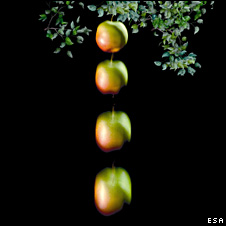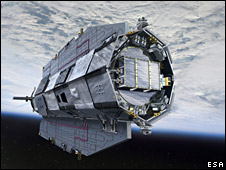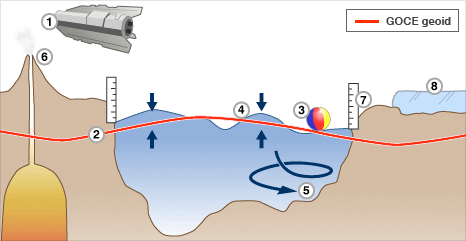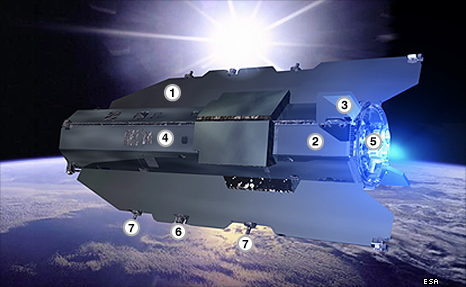091227
Esa satellite senses Earth's pull
Europe's Goce satellite is returning remarkable new data on the way the pull of gravity varies across the Earth.
Scientists say its first maps clearly show details not seen in previous space and ground measurements.
Goce was launched by the European Space Agency (Esa) in March from the Plesetsk Cosmodrome in north-west Russia.
Its information is expected to bring new insights into how the oceans move, and to frame a universal system to measure height anywhere on the planet.
Researchers who study geological processes, such as earthquakes and volcanoes, will also make use of the data.
The first maps built from Goce observations were presented at the American Geophysical Union's (AGU) recent Fall Meeting, the world's largest annual gathering of Earth scientists.
More or less
Although they represent just 47 days of operation following the start of the satellite's science campaign on 30 September, the maps prove Goce is attaining an exceptional level of performance.

GRAVITY - A MOVING TARGET
- The 'standard' acceleration due to gravity at the Earth's surface is 9.8m per second squared
- In reality the figure varies from 9.78 (minimum) at the equator to 9.83 (maximum) at the poles
"There is a tremendous amount of geophysics in these plots," explained Rune Floberghagen, Esa's Goce mission manager.
"You see where there are big variations, for example in the mountain range of the Andes, or the Mariana Trench, or the Indonesian Arc, or the Himalayas. In fact, on most of the continents, you see a lot of variation," he told BBC News.
The maps reproduced on this page illustrate "gravity gradients".
The red colours indicate a positive variation in gravity moving from one place to another - i.e. places where Earth's tug becomes greater.
The blue colours indicate a negative variation in gravity - places where Earth's tug is a little less.
Simply put, if you were to take some bathroom scales to these locations you would weigh fractionally more in red places and weigh less in blue ones.
[[Image::Gravity-earth.jpg]]
Most people are taught at school that the acceleration due to gravity at the Earth's surface - known as g - is about 9.8m per second squared. But, in truth, this figure varies around the planet depending on the nature of the material underfoot.
The planet is far from a smooth sphere; the radius of the globe at the equator is about 20km longer than at the poles.
This ellipsoid is then marked by tall mountain ranges and cut by deep ocean trenches.
The Earth's interior layers are also not composed of perfect shells of homogenous rock - some regions are thicker or denser.
Such factors will cause g to deviate from place to place by very small but significant amounts.
The Gravity Field and Steady-State Ocean Circulation Explorer (Goce) maps these differences with a state-of-the-art gradiometer produced by the French Onera company.
The instrument is sensitive to accelerations of about one-tenth of a millionth of a millionth of g .
And the gradiometer measures these accelerations across all three axes of the spacecraft to obtain a multi-dimensional view of the Earth's gravity field.
"These are by far the smallest accelerations ever measured from orbit," said Dr Floberghagen.
Ocean shape
The first maps not only record the three components but also compare their signals to the best available gravity field models assembled from existing space- and ground-acquired data-sets.
Again, in this challenge to the existing models the Goce gradients appear most pronounced in high latitude and continental regions. The gradients seem less marked over the oceans where a lot of gravity field information has already been determined by spacecraft that measure sea-surface topography.

The Goce team stresses that its data is not yet fully homogenous; some areas of the Earth are currently covered better than others. This is evident in the diagonal stripes that can be seen in a number of the maps. The scientists say that some work also remains to be done in understanding how best to process the data.
Nonetheless, it is hoped that sufficient high-quality information will have been gathered in the opening months of the science campaign to construct what geophysicists call a geoid.
This is a special type of Earth model which traces its idealised "horizontal" surface - the plane on which, at any point, the pull of gravity is perpendicular to it. If you could put a ball on this hypothetical surface, it would not roll - even though it appears to have slopes.
The geoid is of paramount interest to oceanographers who study the causes of the "hills" and "valleys" on the sea surface.
If local gravity differences are not pulling water about to create these features, then other factors such as currents, winds and tides must be responsible.
Extended mission
The mission team also announced at the AGU meeting that Goce is likely to keep flying far longer than anyone had envisaged at launch.
This increase in lifetime is a result of the unusually quiet behaviour of the Sun at the moment. In periods of reduced solar activity, the Earth's atmosphere is less extensive and this means satellites do not experience quite so much drag.
Even at its ultra-low altitude of just 254.9km, Goce requires little effort from its propulsion system to maintain a steady orbit and keep itself from falling out of the sky.
Esa had been expecting the satellite to stay aloft for about two years. Current solar conditions suggest Goce will still be orbiting and gathering science data in five years' time.
"The air drag that we have experienced on orbit after launching has been very different from what any model was able to predict pre-launch," said Dr Floberghagen.
"And that in turn means there is a lot of new science not only in the gravity field measurements but also in the measurements of the surface forces acting on the spacecraft.
"So we plan to generate another product from this mission which will serve modellers of the thermosphere, people who model the air density in the upper layers of the atmosphere."
GRAVITY FIELD AND STEADY-STATE OCEAN CIRCULATION EXPLORER
- Goce senses tiny variations in the pull of gravity over Earth
- The data is used to construct an idealised surface, or geoid
- It traces gravity of equal 'potential'; balls won't roll on its 'slopes'
- It is the shape the oceans would take without winds and currents
- So, comparing sea level and geoid data reveals ocean behaviour
- Gravity changes can betray magma movements under volcanoes
- A precise geoid underpins a universal height system for the world
- Gravity data can also reveal how much mass is lost by ice sheets
- The 1,100kg Goce is built from rigid materials and carries fixed solar wings. The gravity data must be clear of spacecraft 'noise'
- Solar cells produce 1,300W and cover the Sun-facing side of Goce; the near side (as shown) radiates heat to keep it cool
- The 5m-by-1m frame incorporates fins to stabilise the spacecraft as it flies through the residual air in the thermosphere
- Goce's accelerometers measure accelerations that are as small as 1 part in 10,000,000,000,000 of the gravity experienced on Earth
- The UK-built engine ejects xenon ions at velocities exceeding 40,000m/s; the engine throttles up and down to keep Goce at a steady altitude
- S Band antenna: Data downloads to the Kiruna (Sweden) ground station. Processing, archiving is done at Esa's centre in Frascati, Italy
- GPS antennas: Precise positioning of Goce is required, but GPS data in itself can also provide some gravity field information

